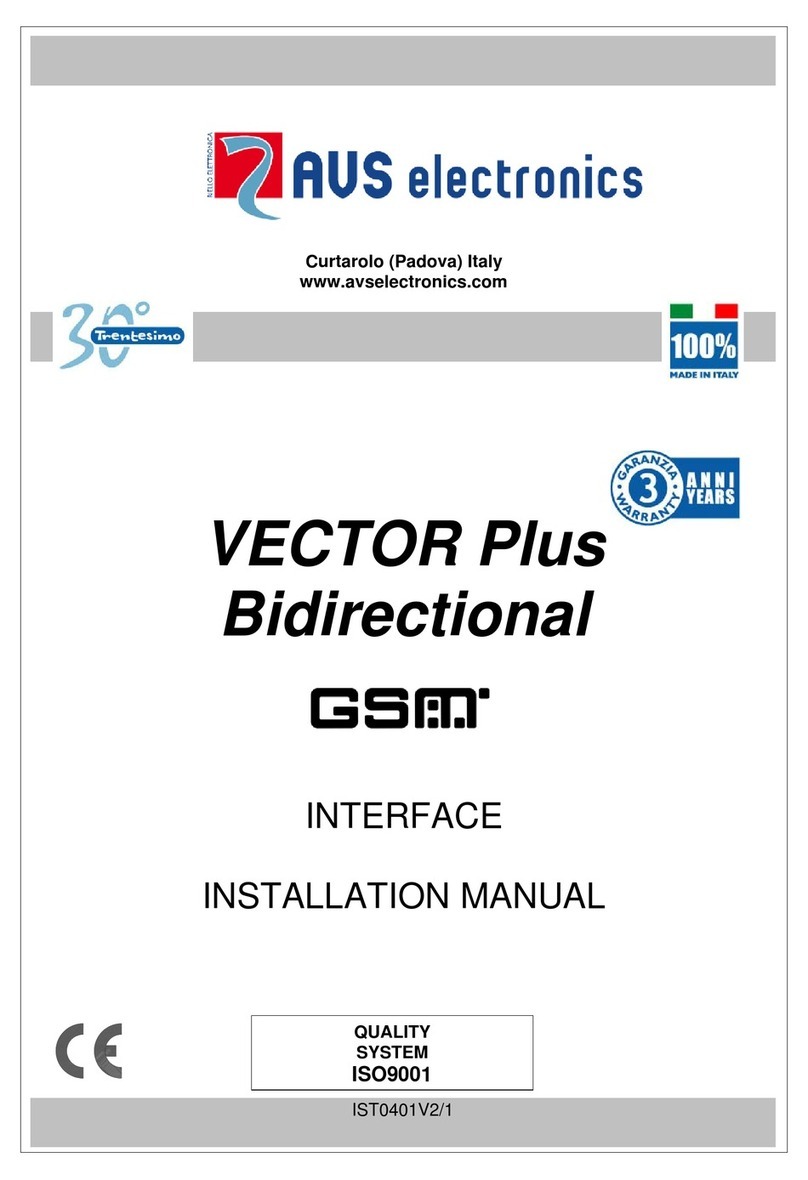
- 5 -
I
T
A
Collegamenti
Mentre per FA, B e TT i collegamenti sono fissi, per STC, +SA e AUX variano in base alla configurazione effettuata.
Esempio 1. Collegamenti con parametri di default (Passi 1 = 3, 2 = 2, 9 = 1 della Tabella Funzioni):
• + / -: Alimentazione sirena
• STC: Ingresso Segnalazione stato impianto (ON / OFF), chiudendolo a Negativo si ha l’accen-
sione a Stato del Led Rosso
• +SA: Ingresso Comando di Allarme, con Positivo presente mantiene in quiete la sirena.
• LED: Ingresso segnalazione Ausiliaria, chiudendolo a Negativo si ha l’accensione a Stato del
Led Verde
Esempio 2. Collegamenti con ingressi bilanciati con resistenza (Passi 1 = 5, 2 = 6, 9 = 1 della Tabella Funzioni):
• + / -: Alimentazione sirena
• STC: Ingresso Segnalazione stato impianto (ON / OFF), bilanciandolo a Negativo con una resi-
stenza da 4k7 Ohm si ha l’accensione a Stato del Led Rosso
• +SA: Ingresso Comando di Allarme, bilanciato a Positivo mantiene in quiete la sirena.
• LED: Ingresso segnalazione Ausiliaria, bilanciandolo a Negativo con una resistenza da 4k7 Ohm
si ha l’accensione a Stato del Led Verde
Funzionamento
Allarme: Sbilanciando l’ingresso SA si attiva il Suono Principale ed il Flash; sbilanciando l’ingresso LED se programmato con
Valore 2 o 3, si attiva il Suono Alternativo ed il Flash (vedi Ingresso LED nella Tabella Funzioni).
Codifica allarmi: se abilitata, blocca il Suono ed il Flash, dopo 5 sbilanciamenti complessivi entro 24 ore dell’ingresso SA e dell’in-
gresso LED, se Passo 9 = 2 o 3 (vedi Codifica Allarmi e Ingresso LED nella Tabella Funzioni).
Programmazione sirena
STAND BY
Sbilanciare l’ingresso Tamper della sirena, il LED VERDE e il LED ROSSO lampeggiano alternativamente a luminosità ridotta e
gli ingressi STC e LED risultano inibiti.
In questa fase è possibile regolare l’intensità luminosa dei LED Verde e Rosso, ad ogni breve pressione del tasto PB1 l’inten-
sità dei led aumenta mentre con PB2 diminuisce.
ACCESSO IN PROGRAMMAZIONE
• dalla fase di STAND BY, premere PB1 o PB2 per almeno 3 secondi (LED VERDE, LED ROSSO e FLASH si accendono di luce fissa)
• non appena il FLASH si spengne, rilasciare il pulsante
• viene visualizzato il primo passo di programmazione dei 13 possibili (1 lampeggio del LED ROSSO, seguito da “X” lampeggi del
LED VERDE)
PROGRAMMAZIONE
• ogni pressione del tasto PB2 fa avanzare in modo sequenziale di un Passo di programmazione, dei 13 disponibili.
• Il Passo selezionato viene visualizzato dai lampeggi del LED ROSSO (vedi NUMERO IMPULSI LED ROSSO nella Tabella
Funzioni)
Esempi: Per spostarsi dal Passo 2 al Passo 8, premere 6 volte il tasto PB2
Per spostarsi dal Passo 11 al Passo 6, premere 8 volte il tasto PB2
• una volta selezionato il Passo da verificare, viene visualizzato il Valore di programmazione impostato, degli 8 possibili, tramite
i lampeggi del LED VERDE (vedi NUMERO IMPULSI LED VERDE nella Tabella Funzioni).
La visualizzazione viene ripetuta fino alla pressione di uno dei due pulsanti PB1 o PB2
• utilizzare il tasto PB1 per modificare il valore del passo selezionato, tenendo conto che, ad ogni pressione, la programmazione
avanza di un valore in modo sequenziale (vedi NUMERO IMPULSI LED VERDE nella Tabella Funzioni)
Esempi: Per spostarsi dal valore 1 al valore 4, premere 3 volte il tasto PB1
Per spostarsi dal valore 6 al valore 2, premere 4 volte il tasto PB1
• i lampeggi del led verde (vedi NUMERO IMPULSI LED VERDE nella Tabella Funzioni) indicano il Valore selezionato che viene
salvato istantaneamente.
USCITA DALLA PROGRAMMAZIONE
L’uscita dalla programmazione può essere effettuata in uno dei seguenti modi:
• bilanciando l’ingresso Tamper della sirena
• tenendo premuto il pulsante PB2 fino al lampeggio alternato dei led verde e rosso
• sbilanciando l’ingresso SA o l’ingresso LED, se Passo 9 = 2 o 3, senza aver modificato almeno un parametro. I n
questo caso la sirena attiva il suo regolare ciclo di allarme.
• per Timeout dopo circa 10 minuti dall’ultima operazione
- Se si eseguono delle variazioni di configurazione, all’uscita dalla programmazione è necessario sbilanciare e successiva-
mente ribilanciare l’ingresso SA o l’ingresso LED, se Passo 9 = 2 o 3, per ristabilire il corretto funzionamento della sirena.
- L’entrata e la successiva uscita da programmazione, azzerano i Guasti, il Conteggio Allarmi e i Timers relativi ai Test
Statico e Dinamico della batteria. Inoltre, durante la Programmazione, viene inibito il Tamper Antivibrazione e le segnalazioni
di Guasto, rimangono attive le segnalazione dei Tamper Sovratemperatura, Antischiuma e gli ingressi di comando +S.A.
(se non è stato variato almeno un parametro), STC e LED.
MORSETTI
CENTRALE
MORSETTI
SIRENA
MORSETTI
CENTRALE
MORSETTI
SIRENA
Oro
Rosso
Viola
Giallo




























